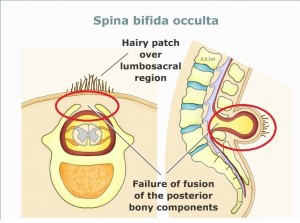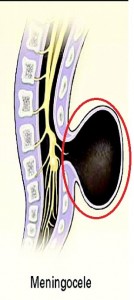Introduction
Before knowing “how common is spina bifida”, it is better to have some introductory knowledge about spina bifida (SB). SB is a congenital birth defect that occurs due to incomplete development of the central and peripheral nervous system and its protective coverings. The central nervous system includes the brain while peripheral nervous system covers spinal cord and nerves. Protective coverings of brain and spinal cord are called meninges. SB occurs during the first month of pregnancy when the spinal column is not fully developed.
Types
Spina bifida is of many types. There are three most common types i.e. spina bifida occulta, meningocele, myelomeningocele.
This is a picture of spina bifida occulta in which there is a defect on the posterior bony components. The red circle on the picture is showing this defect (Source: www.clinicalexams.co.uk).
This is the picture of meningocele in which meninges are protruded out from the posterior bony defect as shown in this picture. The red circle is showing this defect with meninges (Source: www.spinabifida.net).
In myelomengocele, the spinal cord is protruded out along with meninges from the bony defect.
Incidence of spina bifida among people
Approximately 3,000 pregnancies are affected by this congenital birth defect every year. It is more common among people of the United States. According to race, white people are more affected than the black people.
In terms of gender, males are more affected by this than are females . Near the end the writer says the reverse.
The risk of SB is increasing worldwide. On average, one to two children per 1000 births are born with this problem, but in some populations the risk of spina bifida is unexpectedly greater. In the United States, seven out of 10,000 live births are presented with SB. It is seen more among the people of the East Coast than those of the West Coast. The incidence rate among the white people is about one case per 1000 live births. On the other hand, the incidence rate among the black people is low, i.e. one to four cases per 10,000 live births. It is estimated that greater than 70,000 people living in the United States are affected with this type of birth defect.
People who migrated from Ireland have a higher incidence of SB as compared to the general population of the United States. The greatest incidence rate is found among the people of Ireland and Wales; in these countries, about three to four cases of spina bifida per 1000 persons were found during the survey of 1970. The total incidence of spina bifida among the people of the British Isles was 2.0 to 3.5 cases per 1000 live births. A survey done in 1998 found that this incidence was significantly decreased to 0.15 cases per 1000 live births. Part of the reason behind this decline was that some fetuses were aborted after the screening for SB was done during pregnancy and signs were found compatible with this birth defect.
The incidence rate is high among the people of Hispanic in the United States. Hispanic youth is more affected by this birth defect.
Incidence of Spina Bifida Occulta
Spina Bifida Occulta is the lightest form of spina bifida according to the severity of the birth defect. It is also called hidden spina bifida. There is only a defect in the posterior side of the bony component but there is no protrusion of the meninges and spinal cord. Spina bifida occulta mostly develops in the fifth lumbar vertebra or 1st or 2nd sacral vertebra. The incidence of spina bifida occulta is very low. The reasons behind low incidence are given below:
- This is symptomless and the patient is not presented to the doctor. So, this is not reported or under reported.
- Some radiologists consider it as normal anatomical variation and it is not documented in the reports.
Due to the above reasons, most of the persons do not develop symptoms of this birth defect and do not come to the doctor.
Incidence of Meningocele
Meningocele is the out pouching of meninges from the bony defect present in the vertebra but spinal cord segment is not out pouched along with the meninges. This is a moderately severe form of the spina bifida. No neurological deficit is found in such patients as the spinal cord is not protruded out. Parents of the baby bring their child to the doctor with the complaint of an out pouching on the back of child. The meningocele is more common than spina bifida occulta. Nearly fifteen hundred infants are born in the United States with this congenital abnormality every year. The incidence rate of these congenital disorders is different in different countries. But most commonly it is present among the people of the United States. The incidence of meningocele is about one twentieth of the incidence of myelomeningocele.
Incidence of myelomeningocele
Myelomeningocele is that type of spinda bifida in which spinal cord and spinal nerves are protruded out through the bony defect present in vertebra along with meninges. This is the most severe form of SB. In this type, the patient is presented with neurological problems along with out pouching on the back. This is the most common type of neural tube defects. Although the incidence is decreased due to many preventive measures it is still common among in the population. About 0.5 to 1 per 1000 pregnancies are affected by this type of SB.
Incidence according to economies
It is most commonly present among poor people. Poor people do not go to the doctor for antenatal care and do not use the vitamins and mineral supplements to avoid congenital anomalies.
Spina bifida in different age groups
Most of the babies with SB are stillborn or die in their early infancy. Very few children with spina bifida reach adult age. Mothers who are less than 20 years of age or more than 30 have more chance to bear a child with spina bifida.
Spina bifida according to gender
It is more common among the female babies as compared to male babies.
Spina bifida according to ethnicities
It is more common among Hispanic people. White people suffer more from this congenital anomaly as compared to the black people.
References
Persad VL, Hof M, Dube JM, Zimmer P. Incidence of open neural tube defects in Nova Scotia after folic acid fortification. CMAJ. Aug 6, 2002; 167(3): 241–5. Au KS, Ashley-Koch A, Northrup H. Epidemiologic and genetic aspects of spina bifida and other neural tube defects. Dev Disabil Res Rev. 16(1):6-15.





